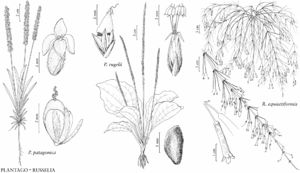Plantago patagonica
Icon. Pl. Rar. 2: 9, plate 306. 1795.
Annuals; roots taproots, slender. Stems 0–15 mm. Leaves (25–)50–120 × 1–4 mm; blade linear, margins entire, rarely toothed, veins conspicuous or not, surfaces villous. Scapes (10–)40–240(–260) mm, hairy, hairs antrorse, long and short and patent, long. Spikes grayish or brownish, 40–120 mm, densely flowered, flowers in whorls or pairs; bracts triangular or narrowly ovate, 2–10 mm, length 1–2 times sepals, apex acute or acuminate. Flowers: sepals 2.2–4.8 mm; corolla bilaterally symmetric, lobes reflexed, 1.6–2.1 mm, base cordate; stamens 4, connective usually elongated, apex acute. Seeds 2, 2.2–2.6 mm. 2n = 20.
Phenology: Flowering early summer.
Habitat: Dry sandy soils, grasslands, openings, disturbed areas.
Elevation: 0–3600 m.
Distribution
Alta., B.C., Man., Sask., Ariz., Ark., Calif., Colo., Ga., Idaho, Ill., Ind., Iowa, Kans., La., Maine, Mass., Mich., Minn., Mo., Mont., Nebr., Nev., N.H., N.J., N.Mex., N.Y., N.C., N.Dak., Ohio, Okla., Oreg., S.C., S.Dak., Tenn., Tex., Utah, Vt., Va., Wash., W.Va., Wis., Wyo., Mexico (Baja California), South America.
Discussion
The circumscription of Plantago patagonica is treated here in accordance with K. Rahn (1978). The phenotypic plasticity of it does not allow varieties or subspecies to be recognized. Plants recognized in other floras as P. purshii (for example, Flora of Indiana and Flora of New Mexico) are referable to either P. aristata or P. patagonica (Rahn).
Selected References
None.
